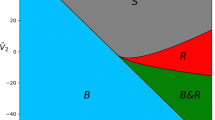Abstract
Basic equations of the perturbational theory of nonradiative multiphonon transitions are reformulated in semiclassical approximation. They are specialized for the mechanisms of static (diabatic) and adiabatic coupling corresponding to the polar alternatives of crossing versus non-crossing oscillator potentials in a two-level-one-mode system. Tunnelling rates are calculated on the basis of contour integrals in the complex co-ordinate plane. These rates for static coupling are proportional to the square of the off-diagonal electron-oscillator interaction as commonly expected. For the alternative of adiabatic coupling we have obtained a non-monotonous (oscillating) pre-exponential transition rate factor. This unfamiliar result is based on a certain “beyondnon-Condon” procedure consisting in a consequent observation both of the familiarnon-Condon effect represented by the Lorentz function behaviour of the non-adiabaticity term and the associatedavoided- crossing (hyperbolic) behaviour of adiabatic potentials in the classical transition region. Present results confirm both the general non-equivalence of both alternative coupling mechanisms and a certain asymptotic approach between mechanism-specific tunnelling rates at small off-diagonal interactions.
Similar content being viewed by others
References
Frenkel J.: Phys. Rev.37 (1931) 17.
Huang K., Rhys A.: Proc. Roy. Soc. A204 (1950) 406.
Pässler R.: Czech. J. Phys. B24 (1974) 322.
Pässler R.: Wiss. Z. TH Karl-Marx-Stadt17 (1975) 381.
Pässler R.: Czech. J. Phys. B32 (1982) 846.
Wagner M.: J. Phys. C15 (1982) 5077.
Haug A.: Theoretische Festkörperphysik II. Deuticke, Wien, 1970.
Born M., Oppenheimer R.: Ann. Phys. (Germany)84 (1927) 457.
Seitz F.: The Modern Theory of Solids. Mc Graw-Hill, New York and London, 1940, sec. 116.
Meyer H. J. G.: Halbleiterprobleme3 (1956) 230.
Stasiw O.: Elektronen- und Ionenprozesse in Ionenkristallen. Springer-Verlag, Berlin-Göttingen-Heidelberg, 1959.
Perlin Yu. E.: Usp. Fiz. Nauk80 (1963) 553.
Wagner M.: Phys. Status Solidi B115 (1983) 427.
Rickayzen G.: Proc. Roy. Soc. A241 (1957) 480.
Gummel H., Lax M.: Ann. Phys. (N. Y.)2 (1957) 28.
Bonch-Bruevich V. L., Landsberg E. G.: Phys. Status Solidi B29 (1968) 9.
Landsberg P. T.: Phys. Status Solidi B41 (1970) 457.
Huang K.: Sci. Sin.24 (1981) 27.
Peuker K., Enderlein R., Schenk A., Gutsche E.: Phys. Status Solidi B109 (1982) 599.
Kovarskii V. A.: Fiz. Tver. Tela4 (1962) 1636.
Kovarskii V. A., Sinyavskii E. P.: Fiz. Tver. Tela4 (1962) 3202.
Sinyavskii E. P., Kovarski V. A.: Fiz. Tver. Tela9 (1967) 1464.
Nitzan A., Jortner J.: J. Chem. Phys.56 (1972) 3360.
Soukup J.: Thesis. TH Karl-Marx-Stadt, 1975.
Ridley B. K.: J. Phys. C11 (1978) 2323.
Helmis G.: Ann. Phys. (Germany)19 (1956) 41.
Pässler R.: Phys. Status Solidi B65 (1974) 561.
Pässler R.: Thesis. TH Karl-Marx-Stadt, 1972.
Kubo R., Toyozawa Y.: Prog. Theor. Phys.13 (1955) 160.
Gutsche E.: J. Lumin.24/25 (1981) 689.
Gutsche E.: Phys. Status Solidi B109 (1982) 583.
Burt M. G.: J. Phys. C15 (1982) L 381.
Burt M. G.: J. Phys. C16 (1983) 4137.
Bartram R. H., Stoneham A. M.: J. Phys. C18 (1985) L 549.
Sharf B., Silbey R.: Chem. Phys. Lett.9 (1971) 125.
Sharf B.: Chem. Phys. Lett.14 (1972) 315.
Leistner G.: Diplomarbeit. TH Karl-Marx-Stadt, 1974.
Stueckelberg E. C. G.: Helv. Phys. Acta5 (1932) 369.
Neumark G. F., Kosai K.: Semiconductors and Semimetals19 (1983) 1.
Markvart T.: J. Phys. C14 (1981) L 895.
Markvart T.: J. Phys. C17 (1984) 6303.
Averbukh I. Sh., Kovarskii V. A., Perel'man N. F.: Zh. Eksp. Teor. Fiz.74 (1978) 1230.
Christov S. G.: Philos. Mag. B49 (1984) 325.
Born M.: Nachr. Akad. Wiss. Göttingen — Math. Phys. Kl. (1951), p. 1.
Landau L., Lifschitz E. M.: Quantenmechanik. Akademie-Verlag, Berlin, 1974.
Pässler R.: Treatise of activation regimes, 1984; unpublished hitherto (see part II).
Dawydow A. S.: Quantenmechanik. VEB Deutscher Verlag d. Wiss., Berlin, 1974.
Teller E.: Isr. J. Chem.7 (1969) 337.
Landau L.: Physik Z. SU1 (1932) 88.
Landau L.: Physik. Z. SU2 (1932) 46.
Zener C.: Proc. Roy. Soc. A137 (1932) 696.
Neumann J. v., Wigner E.: Physik. Z.30 (1929) 467.
Stoneham A. M.: Rep. Prog. Phys.44 (1981) 1251.
Dwight H. B.: Tables of Integrals. Macmillan Comp., New York, 1961.
Bykhovskii V. K., Nikitin E. E., Ovchinikova M. Ya.: Zh. Eksp. & Teor. Fiz.47 (1964) 750.
Pässler R.: J. Phys. C17 (1984) 5957.
Pässler R.: Phys. Status Solidi B86 (1978) K 39.
Pässler R.: Czech. J. Phys. B34 (1984) 377.
Pässler R.: J. Phys. C13 (1980) L 901.
Author information
Authors and Affiliations
Rights and permissions
About this article
Cite this article
Pässler, R. Comparison between static and adiabatic coupling mechanisms for nonradiative multiphonon transitions in semiclassical approximation I. Tunnelling at small relaxation. Czech J Phys 39, 155–195 (1989). https://doi.org/10.1007/BF01597325
Received:
Issue Date:
DOI: https://doi.org/10.1007/BF01597325




